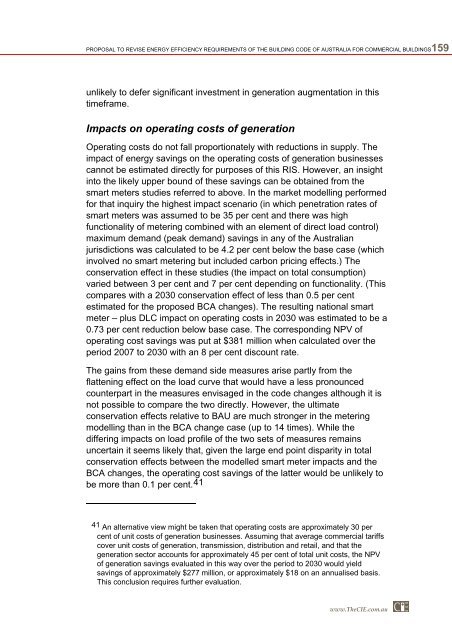PDF | 2 MB - Australian Building Codes Board
PDF | 2 MB - Australian Building Codes Board
PDF | 2 MB - Australian Building Codes Board
You also want an ePaper? Increase the reach of your titles
YUMPU automatically turns print PDFs into web optimized ePapers that Google loves.
PROPOSAL TO REVISE ENERGY EFFICIENCY REQUIREMENTS OF THE BUILDING CODE OF AUSTRALIA FOR COMMERCIAL BUILDINGS 159<br />
unlikely to defer significant investment in generation augmentation in this<br />
timeframe.<br />
Impacts on operating costs of generation<br />
Operating costs do not fall proportionately with reductions in supply. The<br />
impact of energy savings on the operating costs of generation businesses<br />
cannot be estimated directly for purposes of this RIS. However, an insight<br />
into the likely upper bound of these savings can be obtained from the<br />
smart meters studies referred to above. In the market modelling performed<br />
for that inquiry the highest impact scenario (in which penetration rates of<br />
smart meters was assumed to be 35 per cent and there was high<br />
functionality of metering combined with an element of direct load control)<br />
maximum demand (peak demand) savings in any of the <strong>Australian</strong><br />
jurisdictions was calculated to be 4.2 per cent below the base case (which<br />
involved no smart metering but included carbon pricing effects.) The<br />
conservation effect in these studies (the impact on total consumption)<br />
varied between 3 per cent and 7 per cent depending on functionality. (This<br />
compares with a 2030 conservation effect of less than 0.5 per cent<br />
estimated for the proposed BCA changes). The resulting national smart<br />
meter – plus DLC impact on operating costs in 2030 was estimated to be a<br />
0.73 per cent reduction below base case. The corresponding NPV of<br />
operating cost savings was put at $381 million when calculated over the<br />
period 2007 to 2030 with an 8 per cent discount rate.<br />
The gains from these demand side measures arise partly from the<br />
flattening effect on the load curve that would have a less pronounced<br />
counterpart in the measures envisaged in the code changes although it is<br />
not possible to compare the two directly. However, the ultimate<br />
conservation effects relative to BAU are much stronger in the metering<br />
modelling than in the BCA change case (up to 14 times). While the<br />
differing impacts on load profile of the two sets of measures remains<br />
uncertain it seems likely that, given the large end point disparity in total<br />
conservation effects between the modelled smart meter impacts and the<br />
BCA changes, the operating cost savings of the latter would be unlikely to<br />
be more than 0.1 per cent. 41<br />
41 An alternative view might be taken that operating costs are approximately 30 per<br />
cent of unit costs of generation businesses. Assuming that average commercial tariffs<br />
cover unit costs of generation, transmission, distribution and retail, and that the<br />
generation sector accounts for approximately 45 per cent of total unit costs, the NPV<br />
of generation savings evaluated in this way over the period to 2030 would yield<br />
savings of approximately $277 million, or approximately $18 on an annualised basis.<br />
This conclusion requires further evaluation.<br />
www.TheCIE.com.au
















